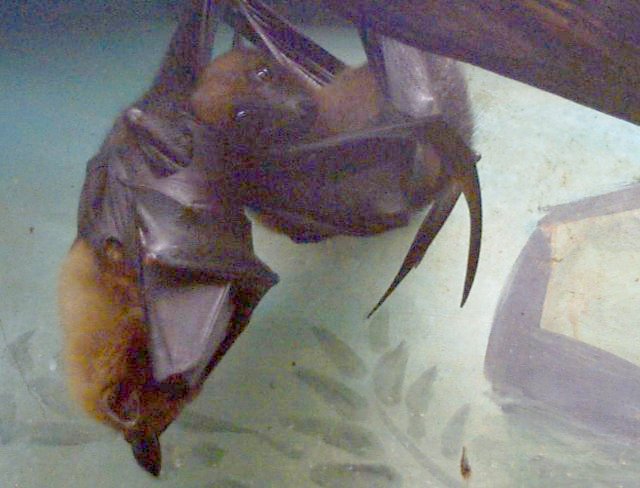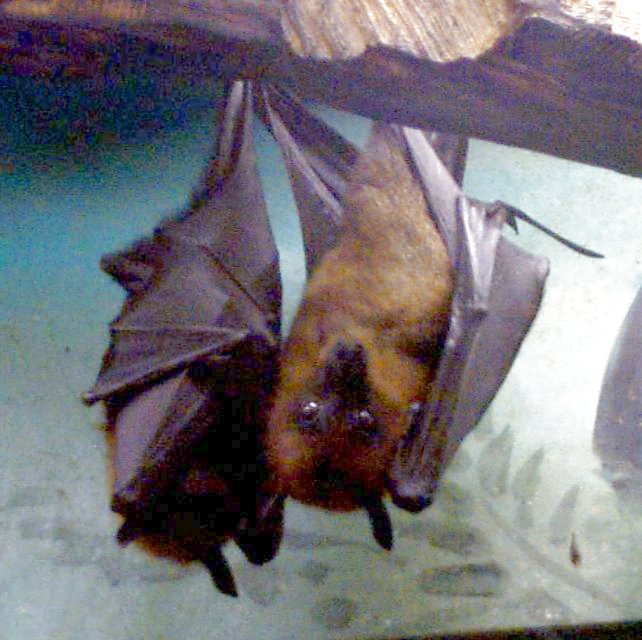The Malaysian Fruit Bat
 Bats
have inhabited the Earth for about the last 50 million years. The earliest fossils
of the species found bare a remarkable resemblance to the bats of today. The
ancestry of bats is thought to be similar to that of primates. This is highly
attributed to their offsprings' dependence upon nurturing and nursing which
is accomplished through a pair of pectoral breasts. These were the factors
which led Linnaeus, the father of modern taxonomy, to link the two species.
Bats
have inhabited the Earth for about the last 50 million years. The earliest fossils
of the species found bare a remarkable resemblance to the bats of today. The
ancestry of bats is thought to be similar to that of primates. This is highly
attributed to their offsprings' dependence upon nurturing and nursing which
is accomplished through a pair of pectoral breasts. These were the factors
which led Linnaeus, the father of modern taxonomy, to link the two species.
Bats vary in their physical make-up. Some have long, angora-like fur, while
others are furless. They range in color from red or yellow to jet black or white.
One species is endowed with pink wings and ears. Another, known as Butterfly
bats, have bright, intricate patterns. Their ears are tiny for some and huge
on others. The world's smallest mammal is the bumblebee bat of Thailand,
which weighs less than a penny. On the other hand, the Flying Foxes of the
Old World tropics have wings spans up to 6 feet!
It is evident that their numbers were once abundant, but over the centuries
the population has decreased due to an increase in the human population.
This could be a factor affecting the health and stability of life today
due to the importance of the mammal in the circle of life. Scientists have
given the name Chiroptera ("winged hands") to the bat family. It is split
into two groups which divide the species: Microchiroptera and Megachiroptera.
The former is highly varied and are found worldwide, while the later is
composed of the Flying Foxes. These bats, named for their fox-like faces
tend to inhabit the Old World tropics. Within the Flying Foxes is the bat
family Pteropodidae, which contains the "Common" Fruit Bat seen and discussed
below.

Malaysian Fruit Bat
Cynopterus brachyotis
|
Fruit Bat: Fort Worth Zoo
| Name: Malaysian Fruit Bat |
| Scientific name: Cynopterus brachyotis |
| Range: Tropical rain forests of Peninsular Malaysia, Sumatra,
Borneo to the Phillipine Islands. . Warm, wet areas where food is available
year round. |
| Habitat: Caves, barns, bridges. Their favorite choice would
seem to be high up in tall trees. |
| Status: Not threatened |
| Diet in the wild: Figs, mangoes, guavas, bananas, and other
tropical fruits. Some feed on nectar through pollination. |
| Diet in the zoo: A mixture of grapes, mango and puppy chow (high
in protein). |
| Location in the zoo: Education Center |
Physical Description of the Fruit Bat:
-
Fox-like face, protruding jaw
-
Short to non-existent tail
-
Normal to large, dark eyes
-
Ears are fully enclosed at the base
-
Hair varies in thickness; generally short and fuzzy; front part of head,
outer parts of limbs and wing membrane are generally bald.
-
Skin is brownish with variation in hue and intensity
-
Wings are usually dark with spotted patterns
-
Teeth are generally 34 in number and do not fully close; the back molars
are flat and wide and used for crushing soft fruits
-
Long and agile tongue
-
Hands have a small claw on the second fingers which are useful in ripping
open fruits; this is a distinguishing factor between Fruit and Insectivorous
Bats.
|
| Eating Habits:
The fruit bat's taste is much like that of humans; they prefer sweet,
aromatic, juicy fruits. Once they find their meal they will either eat
it right of the vine or tree or take elsewhere to enjoy. It is not uncommon
for the bat to crush the fruit and simply drink the juices, while leaving
the remaining pulp to fall to the ground and rot. Some fruit bats will
pollinate flowers, gaining nourishment from the nectar; thus creating a
symbiotic relationship. However, many will chew the "meaty" petals right
off of the flower, killing the blossom.
Large fruit bats must eat a lot to become sated. These bats have large,
expandable stomachs which increase on one side forming a sac-like form.
This trait belongs to the fruit bat alone. The insectivorous bats have
larger intestinal tracts, instead. |
| Navigation and Migration:
Bats communicate and navigate using high-frequency sounds. This method
is so sophisticated and refined that a bat could detect an object the size
of a human hair in total darkness. Bats, being very loyal to their birthplace
and hibernation sight, may use this in some way to plot their way from
one destination to the other but scientists are unaware of exactly how
they find their way back and forth every year. It is thought that certain
patterns and landmarks are passed through generations. Bats tend to migrate
within a 300 mile range to warmer climates where they hibernate for up
to 6 months or more using reserves of stored fat. |
| Environmental Adaptations and Techniques:
When the weather gets warm, about 37 degrees Celcius, bats simulate
the act of perspiring. The fruit bat will lick their breast, stomach, and
wings to the point that it would seem they'd been bathing in water. Then,
they'll fan one of their wings back and forth to create s breeze against
their body. This causes the moisture to evaporate. Thus, cooling them down
When the weather gets cold, about 10 degrees Celcius, they'll wrap
themselves tightly in their winged membrane, tucking their heads, faces,
and any other parts they can manage inside. From that point their warm
breath will become a source of heat. In addition, their usual huddling
together in large groups creates warmth as well. |
| Sleep, Dawn and Dusk:
Fruit bats don't hibernate or fall into deep lethargic daytime sleeps
like the insectivorous bats. Their sleep tendencies are a bit like many
humans. They'll sleep during the daylight hours after a long night's hunt,
and they'll sleep hard if they're tired enough. However, if they are alarmed
in any way, they won't hesitate to check out what the cause was.
When Dusk arrives, the bats will quickly leave their roosting site
(the hanging position is beneficial to this). The first task is usually
a visit to a nearby watering hole. There they will briefly touch the surface
of the water and take off again, drinking as they ascend.
When Dusk arrives, the bats will make their way back to their caves,
barns or trees. There, they'll noisily fly around for sometimes hours at
a time before finally hanging up for the day. |
Ecological and Economic Value:
-
Pollination of certain flowers
-
Fruits such as bananas, breadfruit, avocados, dates, figs, mangoes, peaches
and even tequila rely on them for pollination and/or seed dispersal
-
Source of genetic material for disease resistant strains
-
Rejuvenation of commercial varieties by producing more productive plants
-
Studies of bats have contributed to developing navigational aids for the
blind, birth control, artificial insemination techniques, and vaccines
|
| Comments about the Fruit Bats at the Fort Worth Zoo:
The two fruit bats at the Fort Worth Zoo are found in the Education
Center. They rest during the center's business hours inside a simulated
forest area, separated from humans by a pane of glass. The roost from a
grate in the ceiling side by side. One seems to prefer to hang with one
leg, while the other, seems more comfortable with two. The latter bat was
very aware of activity on the other side of the glass. When movement or
noise was sense, she would untuck her head and target the culprit with
his dark, glassy eyes. Once assured that there was either no danger or
no excitement, she'd tuck her head back into place and snuggle a bit with
his partner. I found them most enjoyable to spend time with even while
they slept. . |

WhoZoo
Home
 Bats
have inhabited the Earth for about the last 50 million years. The earliest fossils
of the species found bare a remarkable resemblance to the bats of today. The
ancestry of bats is thought to be similar to that of primates. This is highly
attributed to their offsprings' dependence upon nurturing and nursing which
is accomplished through a pair of pectoral breasts. These were the factors
which led Linnaeus, the father of modern taxonomy, to link the two species.
Bats
have inhabited the Earth for about the last 50 million years. The earliest fossils
of the species found bare a remarkable resemblance to the bats of today. The
ancestry of bats is thought to be similar to that of primates. This is highly
attributed to their offsprings' dependence upon nurturing and nursing which
is accomplished through a pair of pectoral breasts. These were the factors
which led Linnaeus, the father of modern taxonomy, to link the two species.